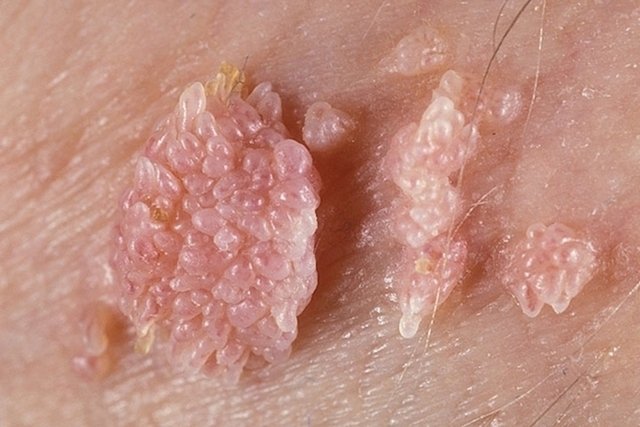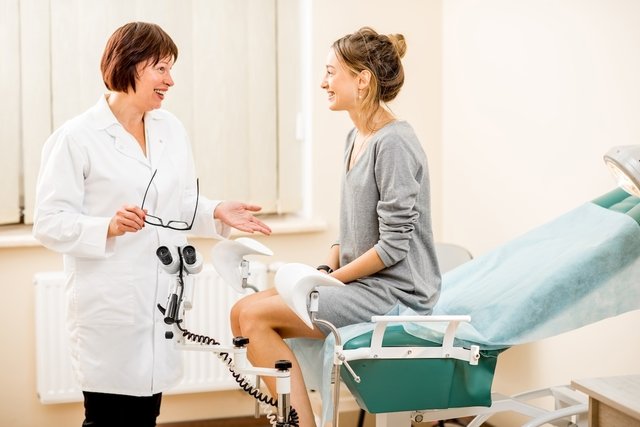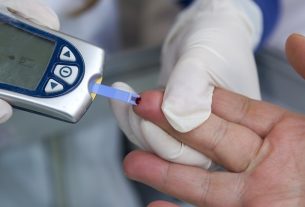HPV in women is an infection caused by the human papillomavirus, transmitted through intimate contact without the use of a condom with a person infected with the virus, and may not cause symptoms or result in the development of genital, mouth or anus warts.
These warts are similar to a small cauliflower, and can cause itching, especially in the intimate area, and depending on the type of HPV virus, can increase the risk of cancer of the cervix, vulva, throat or pharynx.
The treatment of female HPV is carried out by a gynecologist and, although there is no medicine that can lead to a cure, the doctor can recommend treatment with specific ointments or laser sessions.
Sensitive content
This image may contain content that is uncomfortable for some people.

HPV symptoms
The main symptoms of HPV in women are:
- Warts of various sizes on the vulva, labia majora or minora, vaginal wall, cervix or anus;
- Burning at the site of the warts;
- Itching in private parts;
- Warts on the lips, cheeks, tongue, roof of the mouth or throat;
- Formation of plaques by small warts joined together.
Most women do not show any symptoms of HPV, and it is discovered during routine gynecological exams.
This is because the warts characteristic of this infection can take months or years to appear. However, transmission of the infection to an intimate partner can occur, even if there are no signs of infection.
If there are symptoms of female HPV, it is recommended to consult a gynecologist for evaluation and start treatment, as when this condition is not treated it can increase the risk of mouth and cervical cancer.
Read too: Cervical cancer: what it is, symptoms, causes and treatment
How to confirm the diagnosis
The diagnosis of HPV is made by the gynecologist through a cytology test, known as a Pap smear, in addition to evaluating symptoms, health and sexual history and HPV vaccination.
Make an appointment with a gynecologist in the nearest region:
Taking care of your health has never been easier!
Other tests that may be necessary to diagnose HPV are colposcopy to observe the cells in the wall of the vagina, vulva and cervix, and check for lesions that cannot be seen with the naked eye. Check out all the tests that can be used to identify HPV.
In addition, it is also possible to do the HPV test at home, with the HPV self-collection kit, in which the woman collects it herself using a cervical brush provided in the packaging and then sends the material to the laboratory for analysis.
How to stick
HPV infection is a sexually transmitted infection (STI), that is, it is transmitted sexually, with or without penetration, which means that the HPV virus can be transmitted through unprotected vaginal, oral or anal sex, and even through direct contact with the affected skin or mucous membrane.
Although less common, the virus can also be transmitted during birth, from mother to baby. Find out more about how you get HPV.
Read too: STIs in women: 11 symptoms, causes (and what to do)
How the treatment is carried out
The treatment of female HPV must be carried out under the guidance of a gynecologist in order to avoid complications from the infection.
Thus, the following may be indicated:
1. Regular medical follow-up
Depending on the type of HPV virus found in diagnostic tests, the gynecologist may only recommend regular medical monitoring, as the body itself may be capable of eliminating the virus.
However, it is important to carry out medical follow-up as advised, with a Pap smear, in addition to using barrier methods during intimate contact to avoid transmitting the virus to your partner.
2. Use of ointments
The use of ointments, such as imiquimod and podophyllotoxin, may be recommended by the gynecologist for the treatment of genital warts caused by HPV.
These ointments should be used on external genital warts, according to the gynecologist’s recommendation.
In addition, the doctor can also apply a trichloroacetic acid solution directly to the genital warts, this procedure being done in the office due to the risk of damaging the skin around the warts.
Read too: 6 remedies to treat HPV infection (ointments and more)
3. Surgery
Surgery for HPV in women may be indicated to remove warts or when there are lesions on the cervix indicative of cancer.
Therefore, some surgical procedures that can be performed by a gynecologist are cauterization, cryotherapy or conization of the cervix, for example. See all treatment options for HPV.
How to prevent HPV
One of the best ways to prevent HPV infection, at least the most serious forms of the virus, is vaccination with the HPV vaccine.
This vaccine can be given free of charge by the SUS, for girls between 9 and 14 years old, or privately for girls and women between 9 and 45 years old.
Furthermore, it is recommended to use a female or male condom in all sexual relations, including vaginal, anal and oral. See more about the female condom and how to put it on correctly.

Sign up for our newsletter and stay up to date with exclusive news
that can transform your routine!
Warning: Undefined array key "title" in /home/storelat/public_html/wp-content/plugins/link-whisper-premium/templates/frontend/related-posts.php on line 12
Warning: Undefined array key "title_tag" in /home/storelat/public_html/wp-content/plugins/link-whisper-premium/templates/frontend/related-posts.php on line 13




